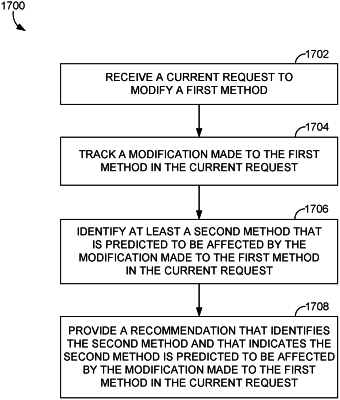| CPC G06F 8/71 (2013.01) [G06F 8/75 (2013.01); G06N 20/00 (2019.01)] | 25 Claims |

|
1. One or more non-transitory computer-readable media having computer-executable instructions embodied thereon that when executed via one or more processors cause the one or more processors to facilitate a plurality of operations, the operations comprising:
tracking, via a tracking feature module, a modification made to a first method;
identifying one or more other methods that are predicted to be affected by the modification, wherein the identifying includes execution of at least a portion of code associated with the first method and performance of at least one trace based on the execution;
determining a score of each of the one or more other methods, wherein the score for a second method of the one or more methods is based at least on:
(a) a first value assigned to each historical occurrence in which the second method was affected by one or more prior modifications of the first method, the one or more prior modifications being made before the modification; and
(b) a second value assigned to each historical occurrence in which the second method was not affected by the one or more prior modifications;
determining that at least one of the one or more other methods has a score that at least meets a threshold; and
generating a presentation, on an electronic user interface, of a recommendation that identifies the at least one of the one or more other methods determined to have the score that at least meets the threshold.
|